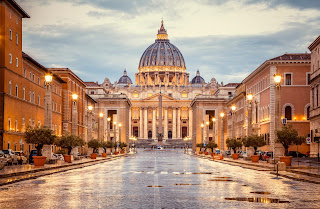The Enigmatic Finances of the Vatican: A Historical Journey from Corruption to Transparency
The Vatican, a monumental pillar of human history and spirituality, has long been an influential entity not just in religious matters but also in global finance. This institution, with its echoing halls in the Vatican City and humble rural chapels worldwide, has amassed significant wealth and political influence over the centuries. However, this journey has been fraught with financial scandals, secretive operations, and moral ambiguities. This essay explores the intricate financial history of the Vatican, from the Renaissance to the modern era, highlighting key events and figures that have shaped its financial landscape.
During the height of the Renaissance, Italy was the epicenter of artistic and intellectual movement, and the Vatican was a powerful political entity. The Church needed an ever-growing source of income to maintain its power and influence, leading to the controversial practice of selling indulgences. This strategy, which allowed the faithful to pay for a piece of paper promising absolution from sins, generated significant income for the Church but also sparked widespread abuse and criticism. Martin Luther’s Reformation, fueled by these abuses, marked a significant financial and spiritual setback for the Vatican.
The late 18th century brought even greater challenges. The French Revolution and the subsequent rise of Napoleon Bonaparte nearly brought the Roman Catholic Church to an end. By 1798, French forces had invaded Rome, ending papal rule over the city and resulting in the death of Pope Pius VI in captivity. However, by the 1830s, the Vatican sought financial salvation through an unlikely alliance with the Rothschild banking dynasty. The Rothschilds lent the Vatican 40 million euros (in today’s money), providing a lifeline that allowed the Church to reform its financial strategies and accumulate assets.
The early 20th century saw the Vatican navigating through two world wars and the Great Depression. Bernardino Nogara, a devout Catholic with Jewish lineage, was appointed as the Church’s financial advisor. His strategic investments in gold, real estate, and bonds helped the Vatican avoid financial collapse during the Great Depression. Nogara also played a crucial role during World War II, moving assets to neutral countries and securing exemptions from U.S. economic sanctions.
In the aftermath of World War II, the Vatican expanded its financial empire, investing heavily in the construction and banking industries. The Church’s financial dealings became more global, leading to partnerships with figures like Michele Sindona and Roberto Calvi. Sindona, a financial hustler with ties to the mafia, and Calvi, known as “God’s Banker,” were instrumental in expanding the Vatican’s financial operations. However, their aggressive and often illegal activities eventually led to massive scandals and financial crises.
The 1980s were marked by the collapse of Banco Ambrosiano, a bank closely tied to the Vatican. Roberto Calvi, the bank’s head, was found hanging from Blackfriars Bridge in London, leading to widespread speculation about the Vatican’s involvement in his death. Michele Sindona, facing legal troubles in the U.S. and Italy, was eventually extradited to Italy, where he died of cyanide poisoning in prison. These events exposed the dark underbelly of the Vatican’s financial operations, involving mafia connections, money laundering, and financial mismanagement.
In the 1990s, the Vatican bank faced unprecedented scrutiny and scandal. Under the leadership of Angelo Caloia, a respected banker, the Vatican attempted to implement financial reforms and increase transparency. However, the Church continued to grapple with legal and ethical challenges, compounded by the global clergy sexual abuse scandal that emerged in the early 2000s. This scandal led to significant financial burdens for the Church, with many dioceses facing bankruptcy and the Vatican experiencing a decrease in donations.
The election of Pope Francis in 2013 marked a new era for the Vatican. Known for his humble and populist approach, Pope Francis initiated significant reforms to increase transparency and compliance within the Vatican’s financial institutions. His efforts to address the clergy sexual abuse crisis and promote ethical finance have helped restore some trust in the Church. Under his leadership, the Vatican bank began publishing annual financial reports, enhancing its transparency and accountability.
The Vatican’s financial history is a complex and often controversial journey. From the sale of indulgences in the Renaissance to the financial scandals of the 20th century, the Church has navigated through numerous challenges to maintain its power and influence. The recent efforts by Pope Francis to increase transparency and accountability represent a significant shift towards ethical finance and a more open financial system. Despite its tumultuous past, the Vatican remains a powerful and influential institution, continuing to play a crucial role in global finance and spirituality.



Comments
Post a Comment